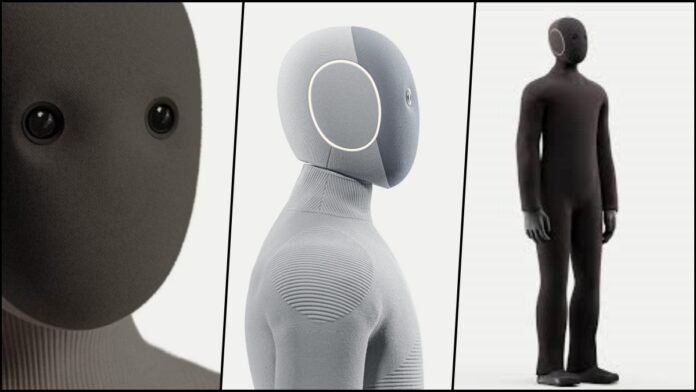
Key Points
- American-Norwegian robotics company 1X Technologies opened pre-orders on October 28, 2025, for NEO, a consumer-ready humanoid robot priced at $20,000 (approximately ₹17.6 lakh) or available via $499 monthly subscription
- NEO weighs just 66 pounds (30 kg) but can lift 154 pounds (68 kg) and carry 55 pounds (25 kg), powered by 1X’s patented Tendon Drive system that operates at only 22dB quieter than a refrigerator
- The 5’6″ tall robot features 22 degrees-of-freedom hands for human-level dexterity, a built-in large language model (LLM) for conversation, and visual intelligence to recognize objects and suggest actions
- “Expert Mode” allows 1X human operators to remotely control NEO for tasks it hasn’t learned yet, raising privacy concerns despite company assurances about user control, no-go zones, and data blurring
- US deliveries begin in 2026 with international expansion in 2027, positioning NEO as a direct competitor to Tesla’s Optimus in the emerging home robotics market
New Delhi: 1X Technologies has launched pre-orders for NEO, marking a significant milestone as the first consumer-ready humanoid robot designed specifically for household tasks. Founded originally as Halodi Robotics by CEO Bernt Børnich and rebranded in 2022, the American-Norwegian company based in Palo Alto, California, officially opened pre-orders on October 28, 2025, shifting humanoid robotics from industrial research prototypes into everyday home environments. The company’s mission is to “create a truly abundant society through general-purpose robots capable of performing any kind of work autonomously,” and NEO represents their most ambitious step toward that vision. According to Dar Sleeper, VP of Product and Design at 1X, “NEO is a humanoid assistant crafted to revolutionize your home life,” merging artificial intelligence with cutting-edge hardware to assist with daily chores and infuse intelligence into routines.
Impressive Physical Specifications and Safety Design
NEO stands 5 feet 6 inches tall (1.65 meters) and weighs only 66 pounds (approximately 30 kilograms), yet possesses remarkable strength capabilities that belie its lightweight construction. The robot can lift up to 154 pounds (about 68 kg) and carry loads of 55 pounds (around 25 kg), with an arm payload capacity of 18 pounds. This impressive strength-to-weight ratio is achieved through 1X’s patented Tendon Drive technology, which uses the highest-torque density motors available to drive tendon-based transmissions rather than the heavy, rigid harmonic drives common in traditional robotics. The lightweight 66-pound design is a deliberate safety feature intended to minimize risk and injury potential if the robot falls or collides with humans.
Soft Body Design and Aesthetic Customization
NEO features a revolutionary head-to-toe soft body made from custom 3D lattice polymer structures, covered by a soft knit suit that gives it an approachable, non-threatening appearance. The company describes the design as “ambient” with neutral tones, making it comfortable to have around the home. Customers can choose from three color options: Tan, Gray, and Dark Brown, allowing some personalization to match home décor preferences. The layered “sweater” is not merely cosmetic but functional, acting as a safer, non-creepy “skin” that serves multiple purposes, including protection and human comfort. The tendon-driven architecture creates gentle, fluid movements that make NEO uniquely safe and compliant around people, avoiding the rigid, mechanical motions typical of industrial robots.
Whisper-Quiet Operation
One of NEO’s most impressive features is its exceptionally quiet operation, generating only 22 decibels of noise, quieter than a modern refrigerator, which typically produces around 40 decibels. This near-silent performance is achieved through the tendon drive system’s low-inertia actuators, which eliminate the grinding gears and loud motors associated with conventional robotic systems. The quiet operation ensures NEO can perform tasks throughout the home at any time without disturbing household members, whether during sleep, work, or leisure activities.
Human-Level Hand Dexterity
NEO’s hands represent a significant technological achievement, featuring 22 degrees of freedom in each hand (44 total), enabling human-level dexterity for precise manipulation of household objects. The hands can move at speeds up to 8.0 meters per second, with remarkable accuracy (1mm precision) and repetition capability (0.1mm). This advanced dexterity allows NEO to perform delicate tasks like folding clothes, handling fragile items, opening doors, and manipulating kitchen utensils with the nuanced control humans take for granted. The hands are rated IP68, meaning they are fully submersible and can handle wet environments like washing dishes. Combined with 7 degrees of freedom in each arm, NEO possesses the manipulation capabilities necessary for the diverse range of household tasks it encounters.
Advanced Mobility and Full-Body Articulation
Beyond its hands, NEO features comprehensive articulation throughout its body, including 6 degrees of freedom in each leg, 3 in the neck, and 2 in the spine. This full-body mobility enables natural, human-like movements for navigation and task execution. The robot can walk at speeds up to 1.4 meters per second (approximately 3.1 mph) and has a maximum running speed of 6.2 meters per second. Using AI-powered navigation, NEO can autonomously move wherever it’s needed in the home, avoiding obstacles and adapting to changing environments. The combination of bipedal locomotion and sophisticated balance systems allows it to navigate typical household terrain, including stairs, though specific capabilities have not been fully detailed.
Built-In Large Language Model for Conversation
At the heart of NEO’s intelligence is a powerful built-in Large Language Model (LLM) capable of understanding natural language, reasoning, and engaging in conversational interactions. The robot features four beamforming microphones that enable it to detect when it’s being addressed and respond appropriately. NEO continuously listens in the background and instantly activates when called by name, similar to virtual assistants like Alexa or Siri. The audio intelligence system interprets audio cues and conversational context, allowing for natural, fluid communication with household members. Three-stage speakers positioned in the pelvis and chest area provide clear audio output, and the robot can serve as a mobile home entertainment system with built-in WiFi, Bluetooth, and 5G connectivity.
Visual Intelligence and Contextual Awareness
NEO employs visual intelligence powered by dual 8.85MP fisheye cameras operating at 90Hz, providing comprehensive environmental awareness. The system uses visual input to enhance conversations and task execution, recognizing objects and understanding spatial relationships. For example, when positioned in a kitchen, NEO can identify ingredients on the counter and suggest recipes based on available items, or recognize suitable cleaning areas and appropriate cleaning methods. This contextual awareness enables the robot to make intelligent decisions about task execution without requiring explicit instructions for every action.
Memory and Personalization Capabilities
NEO features memory functionality that retains information to personalize the user experience over time. The robot can remember household routines, grocery lists, birthday reminders, and individual preferences, adapting its assistance based on learned patterns. This memory capability allows NEO to anticipate needs and provide proactive assistance, such as reminding users of scheduled tasks or recurring events. The personalization grows more sophisticated with continued use as the robot accumulates knowledge about household habits, preferences, and specific requirements.
Redwood AI: The Vision-Language Model
NEO is powered by Redwood, 1X’s proprietary vision-language model specifically designed for learning and performing household chores. This AI system enables NEO to understand both visual and linguistic information simultaneously, bridging the gap between perception and action. The model is trained on real-world data collected from teleoperation sessions, allowing it to adapt to diverse home environments—described by the company as “the world’s most diverse environment”. With each software update, NEO’s capabilities expand as the Redwood model continues learning from accumulated data.
Powerful Onboard Computing
NEO utilizes the 1X NEO Cortex chipset, based on NVIDIA’s Jetson Thor platform, providing up to 2070 FP4 TFLOPS of AI computing power. This powerful onboard processing enables real-time decision-making without requiring constant cloud connectivity, though the robot can leverage cloud resources for more complex tasks. The compute architecture supports simultaneous processing of visual, audio, and linguistic data streams while executing motor control and navigation algorithms.
Expert Mode and Human-in-the-Loop Strategy
NEO’s most innovative—and controversial—feature is “Expert Mode,” a human-in-the-loop training system that allows remote teleoperation by 1X staff. When NEO encounters a task it hasn’t yet learned to perform autonomously, it can request user permission to connect with a human expert from 1X Technologies who takes live remote control to complete the task. The company frames this approach similarly to how Waymo autonomous vehicles operate with supervision and the ability to call for human assistance when needed. According to Eric Jang of 1X, the system is “autonomous + call for human assistance when NEO can’t do a task”. CEO Bernt Børnich describes this as a “social contract” between the company and early adopters, emphasizing that for the product to become truly useful, users must be comfortable sharing data from their homes.
Privacy Safeguards and User Control
Recognizing the significant privacy implications of remote access to a household robot, 1X has implemented several safeguards. The company states that teleoperators will not be able to see people in the home, as humans can be automatically blurred out in the video feed. Users can designate “no-go zones” that software blocks teleoperators from entering, such as bedrooms or bathrooms. Most importantly, remote operators can never connect to a robot without explicit user approval for each session. The company emphasizes that “in this mode, the entire user control and security system remains active,” though skeptics remain concerned about potential vulnerabilities.
Data Collection for AI Training
The teleoperation sessions serve a dual purpose: completing immediate tasks and generating training data for the AI neural network. Videos captured while human pilots control the robot are used to train the Redwood AI model, progressively increasing NEO’s autonomous capabilities. Over time, tasks that initially required human intervention will become fully automated as the AI learns from accumulated examples. This approach allows 1X to deploy NEO to consumers before achieving full autonomy while continuously improving performance through real-world data collection.
Current Autonomy Limitations
Despite promotional materials showcasing NEO performing various tasks, reports from demonstrations reveal that current autonomy is limited. Wall Street Journal reporter Joanna Stern noted during a hands-on demonstration that she “didn’t see Neo do anything autonomously,” every action was guided by a skilled human pilot, “Turing,” who has appeared in previous 1X videos. The company has been transparent about this reality, acknowledging that early units will function more as sophisticated remote-controlled helpers than fully autonomous assistants. NEO will arrive at initial owners with the ability to handle basic tasks like opening doors, fetching items, and turning off lights, with capabilities expanding through software updates and continued learning.
Four-Hour Battery Life with Fast Charging
NEO is powered by an 842 Wh battery pack providing approximately 4 hours of continuous runtime. The battery supports quick charging, requiring only 6 minutes of charging per hour of runtime, meaning a full charge can be achieved in approximately 24 minutes. This fast-charging capability minimizes downtime and allows NEO to maintain operational availability throughout the day with periodic charging sessions. Users can schedule charging during periods when the robot is not actively needed, such as overnight or while family members are away.
Household Tasks and Capabilities
NEO is designed to handle a wide variety of everyday household chores. Promotional videos demonstrate the robot taking out trash, watering plants, folding clothes, cleaning surfaces, picking up items, turning off lights, and even dancing. Users can automate chores through scheduling or execute tasks in real-time using verbal commands or button controls. The robot can empty dishwashers, vacuum floors, organize spaces, and assist with meal preparation by identifying ingredients and suggesting recipes. As NEO’s AI capabilities expand through software updates and accumulated learning data, its task repertoire will grow to encompass increasingly complex household activities.
Pricing and Purchase Options
1X Technologies offers two acquisition paths for NEO. Customers can purchase the robot outright for $20,000 (approximately ₹17.6 lakh or Rs 16 lakh) for early access units with priority delivery in 2026. Alternatively, a subscription model is available at $499 per month, making the technology accessible to those who prefer not to make a large upfront investment. Pre-orders require a $200 (approximately ₹16,000) refundable deposit to secure a place in the delivery queue. The subscription model may include ongoing support, software updates, and potentially hardware replacement or upgrade options, though full subscription terms have not been publicly detailed.
Delivery Timeline and Geographic Availability
Consumer deliveries of NEO will begin in the United States in 2026, with early access units shipped to pre-order customers first. The company plans to expand to international markets in 2027, though specific countries and regions have not been announced. This phased rollout allows 1X to gather feedback, refine manufacturing processes, and address any issues before scaling production globally. The initial US focus also simplifies regulatory compliance and support logistics during the critical early deployment phase.
Competition with Tesla Optimus
Industry experts view NEO as a direct competitor to Tesla’s Optimus humanoid robot, with both companies racing to dominate the emerging home robotics market. While Tesla has shown impressive demonstrations of Optimus performing tasks, 1X has beat them to market by opening actual consumer pre-orders with specific pricing and delivery timelines. NEO’s lighter weight (66 lbs vs Optimus’s reported 125 lbs), quieter operation, and focus on safety through tendon-drive actuation may give it advantages in home environments where close human interaction is constant. However, Tesla’s massive manufacturing scale and integration with its AI and autonomous driving technology could provide competitive advantages once Optimus reaches production.
Safety Features and Certifications
Safety is a central design priority for NEO, reflected in multiple engineering choices. The soft body construction with custom lattice polymer structure minimizes injury risk during accidental contact. Joint structures are designed with no pinch points that could catch fingers or clothing. The low-inertia tendon drives significantly reduce impact force compared to rigid motor-driven joints. The robot’s Head Injury Criterion (HIC) score is less than 250, indicating low risk of head injury from collision. The body is rated IP44 (splash-proof), while hands are rated IP68 (fully submersible), allowing operation in wet environments without risk of electrical hazards.
Technical Precision and Reliability
NEO’s tendon drive system delivers exceptional performance specifications that enable precise task execution. The system achieves 2% torque accuracy and 95% backdrivability, meaning the joints can be easily moved by external forces rather than resisting motion. Repetition accuracy of 0.1mm ensures consistent task performance. The tendons are designed for 2 million nominal load cycles and 100,000 peak load cycles (3x nominal) before requiring service replacement, equating to approximately one day of continuous operation at maximum load—though typical home use would extend component life considerably. Inertial measurement units (IMUs) monitor linkwise differential velocity and acceleration, while AI-based continuous adaptation performs automatic calibration to maintain accuracy over time.
Integration with Smart Home Ecosystems
NEO seamlessly integrates with existing smart home systems through WiFi, Bluetooth, and 5G connectivity. This connectivity allows the robot to interface with smart lights, thermostats, security systems, and other connected devices. Users can incorporate NEO into automated routines, such as turning off lights when leaving home, adjusting temperature settings based on occupancy, or coordinating with smart appliances during meal preparation. The three-stage speaker system enables NEO to function as a mobile entertainment hub, playing music or podcasts throughout the home.
Shift from Labs to Living Rooms
NEO represents a fundamental shift in robotics from laboratory research and industrial applications to consumer home environments. While factories and warehouses offer controlled, structured environments, homes present far greater challenges with diverse layouts, unpredictable objects, pets, children, and constantly changing conditions. The home environment requires robots to exhibit common sense, adaptability, and above all, safety when interacting with vulnerable populations. If successful, NEO and similar home robots promise transformative benefits: time freed from mundane chores, assistance for elderly or disabled individuals, and automation of repetitive tasks that consume hours each week.
Future Potential and Industry Impact
Technology analysts believe NEO has the potential to catalyze the home robotics industry and accelerate the adoption of humanoid assistants. By offering concrete pricing, delivery timelines, and pre-order availability, 1X has moved beyond concept demonstrations to tangible product commitments. The human-in-the-loop training approach, while controversial, may prove to be the pragmatic path to developing robust autonomous capabilities faster than purely simulation-based training. As NEO and competing robots accumulate millions of hours of real-world operational data, their AI models will become increasingly capable and reliable. The home robotics market could grow into a multi-hundred-billion-dollar industry over the coming decade if technical, economic, and social challenges can be successfully navigated.









































Comments are closed.